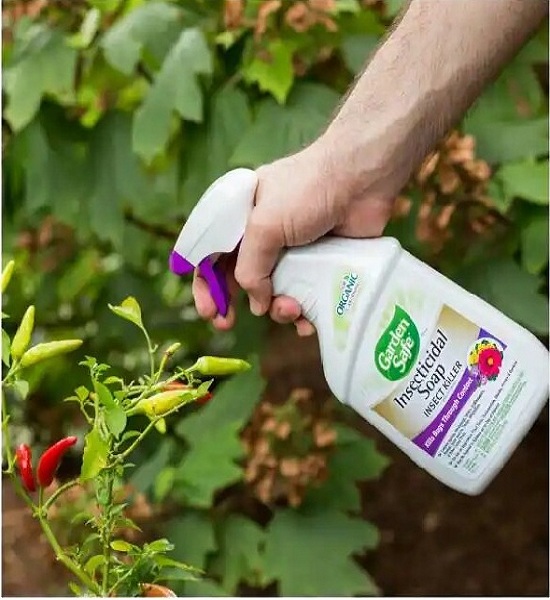Infestations of spider mites are generally accompanied by a general decline in the plant’s appearance and the development of yellow, dry leaves. Fortunately, spider mites can be eliminated in a number of ways.
Use insecticide-containing soaps or oils
Spider mites are rather easy to get rid of using insecticidal soaps or similar products. Frequent treatments are required to get rid of the mite infestation.
Highly refined plant oils, such as citrus, are used in horticultural oil products, and these oils are also quite effective against mites since they suffocate the pests. Oils used in gardening are safer for beneficial insects than chemical pesticides.

Encourage Predators
Spider mites are prey to numerous species of insects and mites. Phytoseiulus persimilis, Amblyseius californicus, and Amblyseius andersoni are just some of the predatory mites that may be acquired at larger garden centers or through internet vendors and applied to plants in need of protection or treatment. Some insects are harmful, but others, like ladybugs, lacewings, predatory thrips, and spined army bugs, are beneficial.
In outdoor environments, where there is a greater variety of insect populations to prey upon spider mites, a hands-off approach may be sufficient.

Use Neem Oil
The neem tree is the source of the natural remedy neem oil. Insects, pests, and mites are killed by neem oil, but it is harmless to humans and most other animals. Azadirachtin, an active ingredient found in neem oil, disrupts the life cycles of insects and mites by stopping them from eating, moulting, mating, and laying eggs.

Use Pyrethroid Pesticide
Natural pyrethrins are the main ingredient of pyrethroid insecticides, which are manufactured by combining pyrethrin with additional compounds. Pure pyrethrin, which is derived from specific chrysanthemum varieties, is a less toxic insecticide.
Even though pyrethroid insecticides are safer than many other synthetic chemical pesticides, they are not called organic because they include additional chemicals. To combat spruce spider mites, pyrethroid insecticides are typically suggested.

Spray With Chemical Pesticide
Malathion, bifenthrin, cyfluthrin, and kelthane are only a few of the commercial chemical insecticides effective against spider mite infestations. These shouldn’t be used unless all other options have been exhausted and there is a very bad infestation of a crucial plant species. Since chemical pesticides can be harmful to both humans and animals, they should be applied with caution, especially around food crops like fruits and vegetables. Carefully reading and according to label instructions is a must.
Since spider mites are notorious for rapidly adapting to pesticides, it is recommended that, if you must resort to many treatments, you switch between different chemical pesticides.

Spray With Water
Regularly spraying plants with forceful blasts of water, aiming mainly at the undersides of leaves or needles, is a very efficient control against mites, which flourish in dry, warm weather. The treatment must be done frequently to prevent the mites from reestablishing themselves on the plants and causing more damage. Houseplants kept indoors can be sprayed down with water from a kitchen or bathroom tap.

Contact a Tree Care Professional or a Specialist in Tree Disease
It’s not easy for householders to cure spruce or other evergreen trees that have been infested by the spruce spider mite, and a qualified expert may have access to more potent insecticides. The use of such powerful pesticides is a last resort and should be avoided unless the loss of a significant tree is imminent.
Causes of Spider Mites
It is well-known that spider mites thrive in dry, hot settings (about 80 degrees is ideal), and that this is also when most mite species are at their peak activity, from July to September. The spruce spider mite, Oligonychus ununguis, is an exception to this rule, as it is most active in the spring and fall when temperatures are lower. Spruce spider mites are a major problem for many kinds of pine trees, as they can lead to slow defoliation and the eventual death of the tree by causing the needles to turn yellow.
Interior plants are more susceptible to mite infestation in the winter because of the dry indoor air, so keep an eye on them throughout the season.
Preventing Spider Mites
Before bringing plants in from the outdoors for the winter, it’s important to make sure they’re in good shape. As spider mites thrive in the dry winter months, it’s advisable to check for them before bringing plants inside. As with homegrown plants, store-bought ones need to be examined thoroughly before being brought indoors.
If you routinely spray your houseplants to dislodge and wash away mites before they can acquire a foothold, and if your interior air is kept damp, you may be able to prevent severe infestations.
Spider mite infestations can be avoided on all plants, whether indoor or outdoor, by giving them a quick drenching every so often. Spider mites, despite their annoying presence, are little enough to be wiped away.


